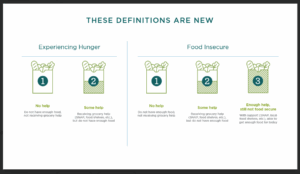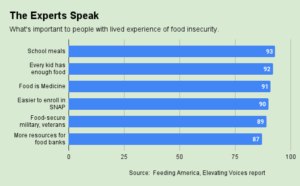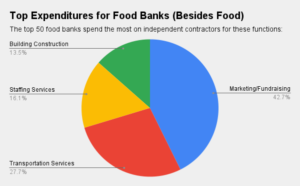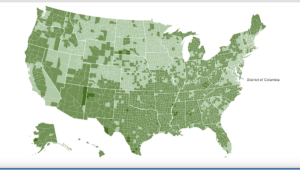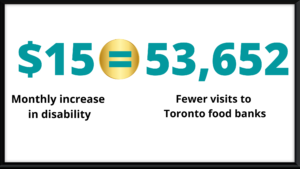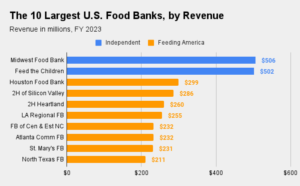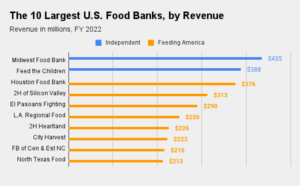Food Bank News’ ranking of the largest ten food banks holds some surprises, especially at the very top.
[For our latest information on the full scope of the food banking sector, please see our 2021 Directory of the Top 300 Food Banks.]
Ranked by revenue, the two biggest food banks in the land emerge as Oklahoma City-based Feed the Children and Normal, Ill.-based Midwest Food Bank. Both are independent food banks, meaning they are not part of the Feeding America national association of food banks.
Houston Food Bank — often cited as the nation’s biggest food bank — in fact is the largest of the Feeding America food banks. In Food Bank News’ comprehensive list, Houston Food Bank ranks as third overall with $209 million in revenue, trailing Midwest’s $278 million and Feed the Children’s $288 million. These three food banks were the only ones to surpass $200 million in revenue.
The more revenue a food bank has, the more resources it has available to put toward the goal of ending hunger.
After the top two, the rest of the food banks on the Top 10 list are all members of Feeding America. Texas emerged as a hotbed of large food banks, with North Texas Food Bank and San Antonio Food Bank joining Houston Food Bank on the list. Logically, the nation’s very first food bank, St. Mary’s of Phoenix, Ariz., ranks highly at No. 4.
Food banks in the Southeast had a strong showing, with the Food Bank of Central & Eastern North Carolina and Atlanta Community Food Bank rounding out the middle of the list. Curiously, the Northeast is represented only by City Harvest and no Top 10 food banks surfaced from the West Coast.
City Harvest, at No. 9, stands slightly apart from its fellow Top 10-ers because of its origins as a food rescue organization. When it started in 1982, City Harvest was the first to focus specifically on rescuing fresh produce and perishable food. Now, more traditional food banks are broadening their scope beyond shelf-stable food to also build capacity for handling fresh food.
In a stirring example of the whole being greater than the sum of its parts, Feeding America itself is a blockbuster in terms of revenue generation. The organization reported revenues of nearly $2.9 billion in its most recent annual report, mostly in the form of donated goods and services.
Feeding America’s nationwide network consists of 200 food-bank members and 74 food-bank distribution partners. The bulk of its donated resources are funneled into programs serving the 274 food banks of the Feeding America network.
The Top Two Food Banks
The Food Bank News ranking puts a new spotlight on Feed the Children and Midwest Food Bank. Unlike the Feeding America food banks, which focus on specific geographic areas usually within one state, the top two independent food banks operate across multiple states, as well as internationally. Their broad geographic focus helps to explain their size.
Feed the Children works in all 50 states, the District of Columbia and ten countries around the world, making it the only food bank to operate in every state. Midwest Food Bank has 11 locations, including nine in the U.S. and one each in East Africa and Haiti.
The two independent food banks also differ from most of their Feeding America counterparts by making broad-based disaster relief a centerpiece of their anti-hunger efforts. Both are in the business of mobilizing in response to far-flung disasters. In March, Midwest Food Bank was one of several organizations cited by Charity Navigator for its emergency response to the Covid-19 pandemic.
Apart from bringing new attention to independent food banks, Food Bank News’ ranking also raises the question of the value of a Top 10 list of food banks. One school of thought says food banks should not be highlighted for their size. Conceived more than 50 years ago as temporary solutions to hunger, food banks instead should be working to put themselves out of business, rather than taking credit for growing larger and serving more meals, according to this line of thinking.
While worthwhile, this point of view rings tone-deaf at a time when so many Americans are struggling under the economic stress caused by Covid-19, putting unprecedented demand on food banks. Before the pandemic, more than 37 million people were food insecure, including 11 million kids. Feeding America now estimates that more than 54 million people, including 18 million children, may not know at some point over a month’s time where their next meal is coming from.
Leading the Fight
As food banks become increasingly entrenched in the food-supply system, there is a need to better understand the sector via industry wide rankings. Although food banks have been battling hunger for more than five decades, they are far from eradicating it. As a start, Food Bank News’ Top 10 list helps to identify the leaders of the ongoing fight, positioning food banks to better hone in on the most effective strategies for ending hunger.
Food Bank News used revenue as a way to rank and better understand food banks because it is uniformly reported by food banks in their tax filings. (More specifically, we used publicly available information from ProPublica’s Nonprofit Explorer as of Sept. 1, 2020, as our source for Form 990 information, supplemented by financial data from food-bank websites.)
But what does it mean for a food bank, as a nonprofit entity, to have revenue?
Often it means that they are receiving donated food. At Houston Food Bank, for example, 81% of total revenue in fiscal 2019, or $170 million, came in the form of donated food to be re-distributed to food-insecure people. Beyond donated food, the revenue pie at most large food banks also generally includes tens of millions of dollars raised through donations, grants, government funds and contracts, and other sources. These funds are available for programs outside of basic food distribution to also support the goal of ending hunger.
Food Bank News sees this inaugural list of the Top 10 food banks as a starting point for ongoing examination of the food banking sector and its work to eliminate hunger. Later this year we’ll expand on the Top 10 by presenting our list of the Top 100 food banks and highlights of the most innovative programs they are running to solve hunger.
By drawing from and building upon these lists, Food Bank News expects to be able to accelerate conversation and information exchange about the best ways to end hunger. Stay tuned!
Research credit goes to Feven Merid, a freelance reporter and recent graduate of Columbia University’s School of Journalism Master’s Program.
Like what you’re reading?
Support Food Bank News
